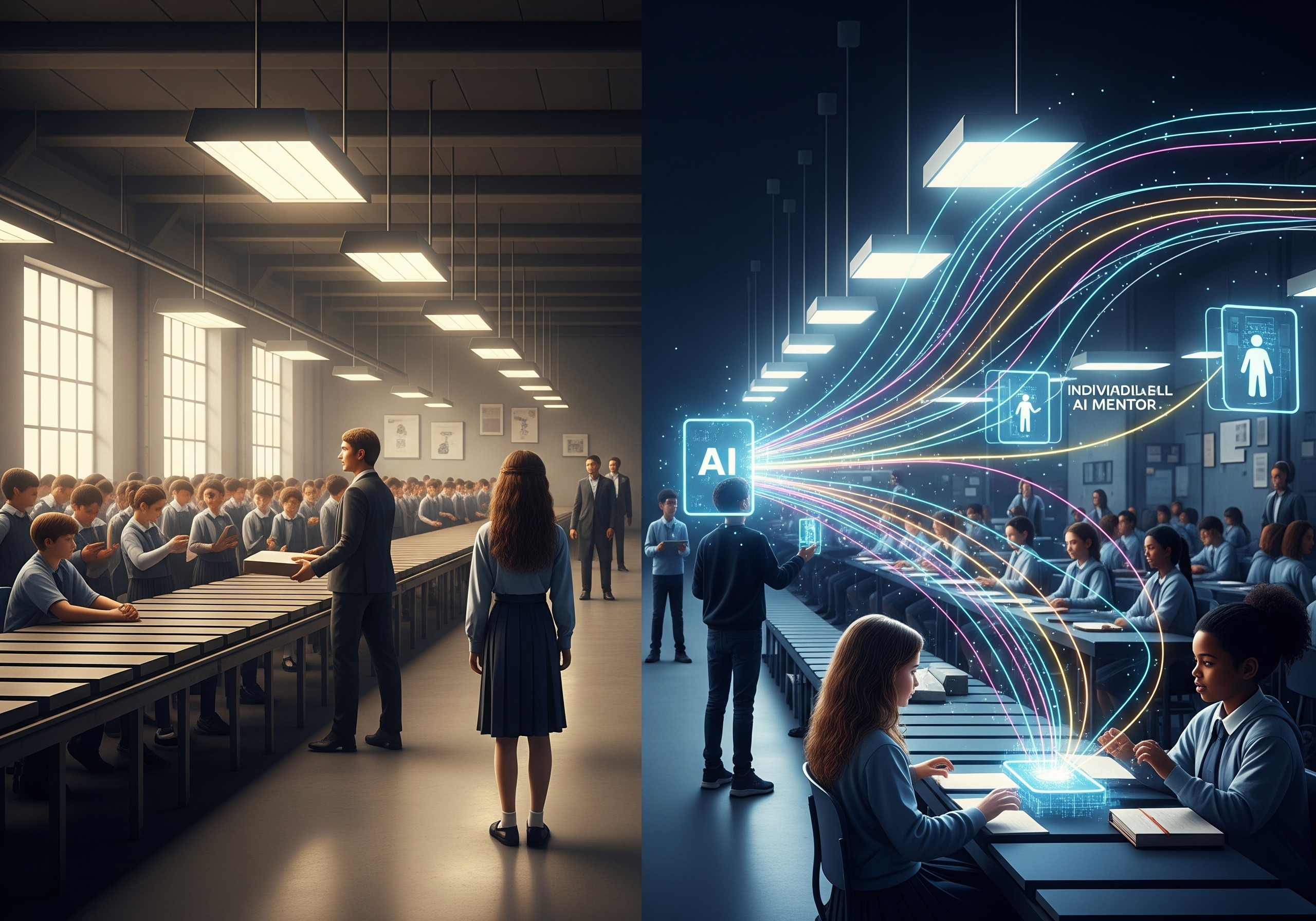1 min read
Public Education Wasn’t Built for Personalization. With AI, We Can Redesign It.
Every classroom has students who are miles ahead and others still struggling to catch up. Most teachers don’t need more data to know that—they live...
Motivention delivers 2× growth for Tier 3 students. Discover how Motivention orchestrates AI, personalization, mastery, and motivation to help Tier 3 students exit intervention—and stay out.

Studient™ redefines what’s possible in Tier 3. Through human-centered AI, motivation science, and mastery-first design, we help districts accelerate growth for students who are furthest behind—without overloading educators.

AI is all around us—but clarity isn’t. Studient™ cuts through the noise with a human-centered approach that honors educators, safeguards students, and delivers real results.

From implementation insights to school-level outcomes, our resource hub helps district leaders and educators go from questions to clarity—fast.

It’s a familiar scene. Another district leadership meeting. Another vendor promising their intervention will be the one that finally closes the gap. The deck is polished. The demo runs clean. The data looks credible. And for a moment, belief flickers.
But the outcomes are rarely different.
Why? Because the tools were built to fit the existing model—30 students, one teacher, fixed periods, standardized pacing, rising expectations. It performs inside the limits. But the limits remain. Results plateau. Hope fades. The search begins again.
Public education has spent decades—and billions—trying to optimize a model built for standardization, not acceleration. It's like upgrading the engine on a freight train and expecting Formula One performance. At some point, we have to ask:
What if the tools aren’t the issue?
What if the real problem is the operating system itself?
Let's be absolutely clear: district leaders and educators aren't failing.
You're performing miracles within an impossible framework. You're asked to personalize learning for every student while teaching to 30 at once. You're told to close achievement gaps while moving at a pace that leaves struggling students further behind. You're expected to prepare students for a dynamic future using a static, industrial-era model.
The data tells the real story of this heroic struggle:
Our education model was brilliantly designed—for the Industrial Revolution. It efficiently processed large numbers of students through standardized curricula, preparing them for predictable careers in a stable economy. The "batch processing" approach made perfect sense when the goal was basic literacy and numeracy for factory work.
But we're asking this 150-year-old operating system to run 21st-century applications. We're patching assembly-line infrastructure with personalization plug-ins and wondering why transformation remains elusive.
Consider the Swiss cheese effect plaguing our students. When a child misses a foundational concept—say, fractions in 4th grade—it creates a learning gap. They move to 5th grade with missing foundational knowledge. Not only does the knowledge gap compound, but so does their feelings about competence and education as a whole. They get locked into a cyclone of negativity without any visible path out. And the curriculum continues on.
By middle school, when fractions become essential for algebra, that small hole has become a chasm. And they have zero positivity left. We patch with interventions, but we’re addressing symptoms while the root problem deepens.
Benjamin Bloom identified the cure in 1984 with his revolutionary 2 Sigma research. Students receiving one-on-one tutoring performed two standard deviations above their peers—moving from the 50th to the 98th percentile. For decades, this remained education's "impossible dream" due to economics. Human tutoring costs $30,000-$50,000 per student annually—economically unfeasible for public education.
But what was impossible in 1984 is inevitable in 2024. The question isn't whether we can achieve Bloom's 2 Sigma effect at scale—it's whether we're ready to stop patching and start transforming.
Here's the crucial distinction: tools are features you add to existing workflows. Systems are complete operating environments that produce predictable outcomes. Tools work within constraints. Systems redefine what's possible.
A learning system that actually works for each student requires three inseparable elements working in perfect harmony. Remove any one, and you're back to expensive patches on a broken foundation.
Pillar 1: AI-Powered Personalization That Goes Beyond Adaptation
Today's AI capabilities represent a quantum leap from simple adaptive learning or digitized curriculum with a ChatBot. We're not talking about software that just adjusts difficulty. We're talking about AI that:
The technology isn't theoretical. This is human-centered AI, built to support teachers, not replace them. Motivention can now deliver truly individualized instruction to every student simultaneously, something impossible even five years ago. The cost curves have inverted: what required $150/hour for human tutoring now costs $2-5 per student per day.
Pillar 2: Motivation Science that Builds Confidence
Here's our industry's uncomfortable truth: AI alone isn't enough for educational success. In fact, AI is only part of the solution. We've watched AI-only platforms launch with fanfare and fail with barely a whisper. Why? They ignored the human element.
Motivation is 90% of the solution to educating kids. This isn't opinion—it's science. Self-Determination Theory shows us that sustainable engagement requires three elements:
The breakthrough isn't just understanding this—it's systematizing it. When students trade 6 hours of fragmented classroom time for 2 hours of focused, personalized learning combined with motivational frameworks to support their individual needs, something magical happens. They get their time back…and so do teachers. Suddenly, learning isn't something done to them—it's something they choose for efficiency and growth.
Pillar 3: True Mastery Standards that Build Unshakeable Foundations
Perhaps our greatest educational scandal hides in plain sight: we advance students with 60-70% understanding. Imagine building a house where each floor is only 60% complete. By the third floor, collapse is inevitable.
True mastery means 90% proficiency before advancement. It means building unshakeable foundations rather than shaky progress. It means that each student is genuinely ready for the next concept, not barely scraping by.
When Mississippi schools implemented mastery-based progressions with proper support, "failing" students suddenly achieved grade-level performance. They mastered content, and filled in the gaps to firm their academic foundation.
Like a three-legged stool, remove any element and the system collapses. AI without motivation leads to abandonment. Motivation without mastery leads to false confidence. Mastery without AI remains economically impossible. Together, they create an entirely new operating system for learning.
Motivention™, Studient’s human-centered learning system, combines all three—AI-powered personalization, motivation science, and mastery progression—into one seamless experience.
Callout box: Why Precision Matters in Intervention
Most intervention tools rely on broad groupings and static pathways. Motivention™ adapts instruction every few minutes based on 50+ learning signals—from performance to engagement. The result? A level of precision that eliminates wasted time, minimizes student frustration, and delivers consistent growth.
Today's district leaders face a defining choice: continue managing decline with incrementally better patches, or pioneer the transformation our students desperately need.
Investing in AI isn't about technology for technology's sake. It's about finally delivering on education's promise: helping each student reach their full potential.
Imagine:
Moving from fixing to replacing requires courage. The familiar dysfunction feels safer than unfamiliar transformation. But consider the real risk: continuing to fail our students with incremental improvements to a fundamentally flawed design. This affects everyone’s future.
The economics make the decision clearer. Traditional education costs $10,000–$15,000 per student for 50th percentile outcomes. One-on-one tutoring achieves Bloom’s famous 2 Sigma effect—98th percentile performance—but costs $20,000–$30,000 more per student.
Motivention™ models a new path forward: by combining human-centered AI with precision orchestration, motivation science, and mastery-based progression, we can deliver outcomes approaching the 95th percentile—for just $1,000–$3,000 more per student annually. The result: tutoring-level impact, at scale.
The ROI extends beyond test scores:
Reduced dropouts.
Decreased remediation.
Increased college readiness.
Elevated teacher satisfaction.
These aren't projections—they're results already happening in pioneering districts.
While some debate whether transformation is possible, forward-thinking districts are already proving it's inevitable. They're not waiting for permission to revolutionize learning. They're not pilot-testing another band-aid. They're building the future, one student at a time.
In five years, every district will use AI-powered personalized learning. The only question is whether yours will be leading the transformation or scrambling to catch up. History remembers the pioneers who saw possibility where others saw problems—the leaders who chose courage over comfort.
In real-world implementation, students using Motivention™ have shown MAP Conditional Growth Percentiles (CGPs) well above 60—confirming over 2X typical academic growth when compared to national benchmarks. Districts don’t just get results, they get accountability. Studient only succeeds when your students do.
The students in your district can't wait for the system to slowly evolve. They need transformation now. They need leaders willing to acknowledge that better patches won't fix foundational flaws. They need you to stop managing failure and start engineering success.
The choice isn't between risk and safety—it's between certain stagnation and possible transformation. Which future will you choose for your students?
Ready to explore what a true learning system looks like for your district? Join the growing coalition of educational pioneers already making transformation reality with Motivention by Studient. The future of learning isn't coming—it's here, waiting for leaders with the courage to embrace it.
Continue exploring AI in education with these carefully curated articles even more innovative applications that will reshape how we teach and learn in the digital age.

1 min read
Every classroom has students who are miles ahead and others still struggling to catch up. Most teachers don’t need more data to know that—they live...

2 min read
In most schools, students move on when they’ve scored a 70% or maybe an 80% on a unit. But here’s the overlooked reality: 70% mastery means 30%...

1 min read
Artificial Intelligence is no longer a futuristic concept—it's actively reshaping how we approach education today. From personalized learning...